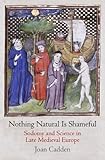Nothing Natural Is Shameful : Sodomy and Science in Late Medieval Europe / Joan Cadden.
Material type: TextSeries: The Middle Ages SeriesPublisher: Philadelphia : University of Pennsylvania Press, [2013]Copyright date: ©2014Description: 1 online resource (336 p.) : 8 illusContent type:
TextSeries: The Middle Ages SeriesPublisher: Philadelphia : University of Pennsylvania Press, [2013]Copyright date: ©2014Description: 1 online resource (336 p.) : 8 illusContent type: - 9780812245370
- 9780812208580
- 306.77
- HQ76.2.E9 -- C33 2013eb
- online - DeGruyter
- Issued also in print.
| Item type | Current library | Call number | URL | Status | Notes | Barcode | |
|---|---|---|---|---|---|---|---|
 eBook
eBook
|
Biblioteca "Angelicum" Pont. Univ. S.Tommaso d'Aquino Nuvola online | online - DeGruyter (Browse shelf(Opens below)) | Online access | Not for loan (Accesso limitato) | Accesso per gli utenti autorizzati / Access for authorized users | (dgr)9780812208580 |
Frontmatter -- Contents -- Introduction: The Natural Philosophy of Sodomites and Their Kind -- Chapter 1. Moved by Nature -- Chapter 2. Habit Is a Kind of Nature -- Chapter 3. "Just Like a Woman": Passivity, Defect, and Insatiability -- Chapter 4. "Beyond the Boundaries of Vice": Moral Science and Natural Philosophy -- Chapter 5. What's Wrong? Silence, Speech, and the Problema of Sodomy -- Epilogue -- Appendix. Pietro d'Abano, Expositio Problematum Aristotelis, IV.26: A Text -- List of Abbreviations -- Notes -- Manuscripts Consulted -- Works Cited -- Index -- Acknowledgments
restricted access online access with authorization star
http://purl.org/coar/access_right/c_16ec
In his Problemata, Aristotle provided medieval thinkers with the occasion to inquire into the natural causes of the sexual desires of men to act upon or be acted upon by other men, thus bringing human sexuality into the purview of natural philosophers, whose aim it was to explain the causes of objects and events in nature. With this philosophical justification, some late medieval intellectuals asked whether such dispositions might arise from anatomy or from the psychological processes of habit formation. As the fourteenth-century philosopher Walter Burley observed, "Nothing natural is shameful." The authors, scribes, and readers willing to "contemplate base things" never argued that they were not vile, but most did share the conviction that they could be explained.From the evidence that has survived in manuscripts of and related to the Problemata, two narratives emerge: a chronicle of the earnest attempts of medieval medical theorists and natural philosophers to understand the cause of homosexual desires and pleasures in terms of natural processes, and an ongoing debate as to whether the sciences were equipped or permitted to deal with such subjects at all. Mining hundreds of texts and deciphering commentaries, indices, abbreviations, and marginalia, Joan Cadden shows how European scholars deployed a standard set of philosophical tools and a variety of rhetorical strategies to produce scientific approaches to sodomy.
Issued also in print.
Mode of access: Internet via World Wide Web.
In English.
Description based on online resource; title from PDF title page (publisher's Web site, viewed 30. Aug 2021)


